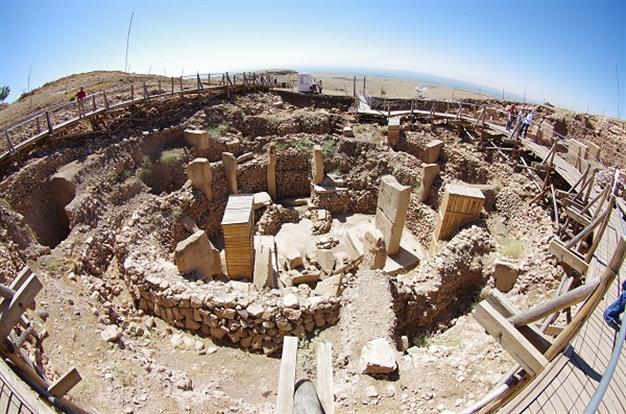FULL STORY: How 'the world's oldest temple' changed history
Ertuğrul ÖZKÖK / Saffet Emre TONGUÇ

When Dr. Schmidt saw the craftsmanship on the circles and stones, he turned to his colleagues and said, “Creating these stones and circles with the means of that day is like building a Boeing in your basement today.”
I had started my day with a coffee as usual. I saw that word at the daily Cumhuriyet in an article written by Özgen Acar: “Wish tree.”The article was about the great archeologist who we lost on July 20: Dr. Klaus Schmidt.
What Klaus Schmidt discovered in Göbeklitepe, I believe, has potential to change many things in the history of humanity and the history of our beliefs.
A group of archeologists from the universities of Chicago and Istanbul visited the southeastern town of Şanluıurfa in 1963. It looked like a routine visit. When they reached the hill 10 kilometers away from Şanlıurfa, they noticed a tree. The tree that was standing by itself all alone in an empty terrain was impressive. It was a mulberry tree and local people called it “the wish tree.” People have been going to the tree to make wishes since ancient times.
While the archeologists were examining the tree, one of them noticed a small hill a bit further away.
The texture of the soil was different; it was as if it was hiding something. They examined it for a while, began to dig slightly and came across some lime stones. The Chicago archeologists went back to their countries and wrote reports on their findings. They wrote that there were no noteworthy discoveries from that hill. They claimed that it was probably a Byzantium outpost and that the stones belonged to a grave stone. The file was then closed. The tree had given its first signal, but it went unnoticed.
Some 25 years later, a villager named Şavak Yıldız who was practically born and lived under that tree, found a set of two sculpture-like objects in 1988. He looked at them for a while but continued with his work. He brought them home in the evening. His nephews and relatives then looked at them for a while with one of them suggesting that he should sell them to the antique shop. However, Şavak Yıldız was determined: “I am going to take them to the museum.” They told him it was too far away, but he set out the next morning, with the hope of an award in his mind.
After a long journey he arrived at Şanlıurfa Archeological Museum. The Museum Manager Adnan Mısır looked at the two small figurines, and then told Şavak: “They are useless, you may take them back.”
Şavak Yıldız was upset. “What can I do with them? You keep them.” While he headed back to his village, he was not aware he had carried a sign that could change the history of humanity to Şanlıurfa Museum. The Museum manager told the superintendent to put the figurines in the storehouse. They had not noticed the second sign the tree had sent.
The mysterious statues, like an Indiana Jones film, were in dark storage room waiting for the next person to discover them. Six years later, that would happen at a library in Berlin.
A person reading the report in the library of the German Archeology Institute in Berlin in 1994 said, “This cannot be true” after he finished reading the report. His name was Klaus Schmidt and he was 41 years old. He had found the Chicago University report by coincidence, read it to its last detail and was stuck at the sentence: “These findings may belong to a Byzantium outpost.” He was surprised that nothing noteworthy was found after these discoveries as he had some knowledge of the region’s history. It was not possible that what was discovered had belonged to the Byzantium’s. A voice inside told him that there was a very important thing there. He then decided that he had to go immediately. The sign coming from the tree at Şanlıurfa had finally been found.
When Klaus Schmidt entered Şanlıurfa Archeology Museum one week later, a journey that would change the course of humanity and religious history began. The tree was finally able to make its voice heard. Maybe the first divine message of the history of humanity was coming from the roots of that tree. Professor Klaus Schmidt was sure that the tree on that hill was hiding the biggest secret of humanity, religions and beliefs…
“The Big Bang of belief had occurred there and constituted the first black hole…”
Maybe that divine voice that called Prophet Abraham to those lands came from under that tree.
A while after he started digging, he was to come across such a thing that many archeologists and conspiracy theorists alike would turn their eyes too. Göbeklitepe which kept silent for 11,000 years was talking for the first time…
A woman visiting the Şanlıurfa Museum stood in front of a statue for a while. The top of this statue was like a lion’s head, the mid part was like a human and the bottom had a baby. A snake was around the statue. The visitor stared at the statue for a long time and then moved on.
However, Dr. Schmidt was more careful than an ordinary visitor. He most probably cried, “Oh my God. This is that place. This tree is that tree…” when he saw that design for the first time.
Schmidt spent the fall of 1994 walking around that area. When excavation started one year later, he recognized how difficult his task was. The first hope of finding a major breakthrough came around the end of the 1990s, as some circles appeared in the excavated area.
They were like a space design. Then they reached those stones. Dr. Schmidt thought of the famous Stonehenge monument in England.
All the stones that were found were “T” shaped. They looked like people with opened arms. They were 5.4 meters high. All of them were staring at circles in front of them.
There was something in those circles and those stone people were like the moths of whatever was at the center of these circles. They were enchanted by it.
Questions were to get deeper and the physical findings were to be intermixed with metaphysical questions.
But before anything else, there was a physical question to be answered: Who brought these stones there and how?
This looked like a simple question but it was not as the stones weighed about 16 tons.
History books and the science of archeology do not have precise information on the taming of the beasts of burden. The only information known was that the donkey was being used as a beast of burden in Egypt around years 3,000 B.C.
There was no strong evidence to suggest that the beast of burden was tamed in these lands that they were from 8,000 B.C. Well, since men cannot move such a heavy stone, then who carried these 16-ton blocks there and erected them?
It was as if the stones had been carried by a divine power and placed there…
In the excavations done, they had found “T” stones but there was no trace of any human beings living there. There was not even one mark that human beings ever lived there: No wall of a house, no stone where they built fire and cooked their meals. Also there were no water sources nearby. The nearest one was 5 kilometers away. While physical questions increased, mystic questions also multiplied and scientific explanations were difficult to find.
As of the mid-2000s, they had gone down quite deep from the roots of that tree.
Circles were followed by circles and they were traveling to the main circle. But they noticed a striking fact those days. The animal figures they found in the top levels were normal for that era. They were very much like the wall drawings found in ancient caves.
However, as they dug deeper, they were appalled. Because the designs they found on the tablets that dated back to 11,000 B.C. were perfect. They were drawn by a master. Also the stonework of the “T” people was also perfect. Who was this perfect artist? How did this “perfect artist” do these drawings?
As they dug, it became darker. What was this place? Who designed this strange venue?
Dr. Schmidt put this note in his notebook: “Every puzzle we solve creates two more puzzles…”
When the 2000s were coming to an end, a new stone tablet was excavated: Dr. Schmidt froze when he saw the design on the tablet. There was a naked woman design there, maybe a woman giving birth. Maybe the first woman. There was a tree and a naked woman…
His Christian memory immediately merged two images… Everything he had looked for was right in front of him now…
The silent lady that drew nobody’s attention at the Şanlıurfa Museum had now started to talk…
When the tip of the statute was seen above ground, the sun was about to set. They were about to call it a day, but the statue excited the archeologists and they continued on and so did Dr. Schmidt.
Half of the statue was excavated when the tired archeologist stopped his work. The next day someone knocked on his door, his assistant was telling him that there was a problem. When they arrived at the excavation site, the statue was gone. It was a nightmare for foreign archeologists in Turkey. This was the biggest disaster that could happen to a foreign archeologist in Turkey, a country which is still traumatized by the moving of the entire Bergama (Pergamon). Dr. Schmidt was a suspect. Almost everybody knew that the German archeologist had nothing to do with this; he was only after the story these statues were telling.
That statue was never found. The theft, it was later understood, was a result of two groups clashing with one another.
Dr. Schmidt was searching for the meaning and the place of the naked woman among all these mortal male animals. He was sure of one thing: All these cosmic circles and stone human figures were clearly depicting this message to us: This was a place to conduct religious ceremonies. But, since no human being lived there, who was conducting the ceremonies? Then he thought, maybe this place was a pilgrimage site. He thought of other pilgrimage sites: Mecca, Vatican, Jerusalem, Bodh Gaya where Buddha was enlightened. Cahokia, the holy place of the North American natives…
Could this be the first pilgrimage site of history? His deputy said, “But Dr. Schmidt, there was no religion at these times…”
The site they were excavating dated back to 8,200 B.C., a time when people had not settled as it was a hunting and gathering period. Once people settled, then religions and beliefs started.
The finding of Göbeklitepe revealed that religions and beliefs started before human kind entered the settlement phase.
These excavations showed us that the history of humanity and beliefs may not be as they had taught us.
Maybe the black hole of belief started under that tree.
When Dr. Schmidt saw the craftsmanship on the circles and stones, he turned to his colleagues and said, “Creating these stones and circles with the means of that day is like building a Boeing in your basement today.”
Yes, some kind of a power we do not know today has set up a belief cosmos there in the year 8,200 B.C.
We do not know who that competent artist is. Was it human beings or was it a divine power?
But we know one thing: Prophet Abraham, who we know as the founder of monotheistic religions, started his divine walk in these lands taking humanity into a new system of relationships.
That tree must have had a symbolic meaning.
Dr. Schmidt said Göbeklitepe was a temple in the Garden of Eden where Adam and Eve lived.
Maybe the fruit that the naked woman on those T stones ate was not the apple but the mulberry?
The black hole of belief is full of unknowns.
Just as how the meteors that fall into black holes go down with a speed faster than the speed of light and can never come back; maybe the thought of “the other world” is also such a black hole?
Nobody has ever come back from there.
It is up to us, the people to interpret the blanks left by the black hole...
The story of that tree ends here.
Archeologists continue digging the black hole of belief. In Switzerland’s CERN laboratories, people are searching for the god particle. They believe the universe was created after a Big Bang. Black holes were formed after this big bang.
After the excavations in Göbeklitepe, I am asking to myself: Did religions form after such a big bang?
Is the black hole of belief under that tree?
















